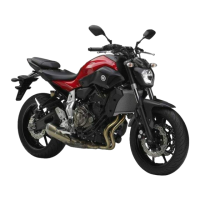Operation and important riding points
5-2
5
ECA20790
If the above warning or indicator
lights do not come on initially
when the key is turned to “ON”,
or if a warning or indicator light
(except the oil pressure warning
light) remains on, see page 3-4
for the corresponding warning
and indicator light circuit check.
After going off once, the oil
pressure warning light will
come back on until the engine is
started. If the warning light does
not come on, or if the warning
light does not go off after start-
ing the engine, see page 3-4 for
the engine oil pressure warning
light circuit check.
For ABS models:
The ABS warning light should
come on when the key is turned to
“ON”, and then go off after travel-
ing at a speed of 10 km/h (6 mi/h)
or higher.
ECA17682
If the ABS warning light does not
come on and then go off as ex-
plained above, see page 3-4 for the
warning light circuit check.
2. Shift the transmission into the
neutral position. The neutral indi-
cator light should come on. If not,
ask a Yamaha dealer to check the
electrical circuit.
3. Start the engine by sliding the
switch toward “ ”.
If the engine fails to start, release
the start/engine stop switch, wait
a few seconds, and then try again.
Each starting attempt should be
as short as possible to preserve
the battery. Do not crank the en-
gine more than 10 seconds on any
one attempt.
ECA11043
For maximum engine life, never ac-
celerate hard when the engine is
cold!
EAU16673
Shifting
Shifting gears lets you control the
amount of engine power available for
starting off, accelerating, climbing hills,
etc.
The gear positions are shown in the il-
lustration.
To shift the transmission into the neu-
tral position, press the shift pedal down
repeatedly until it reaches the end of its
travel, and then slightly raise it.
1. Shift pedal
2. Neutral position
U1WSE3E0.book Page 2 Monday, June 8, 2015 10:12 AM

